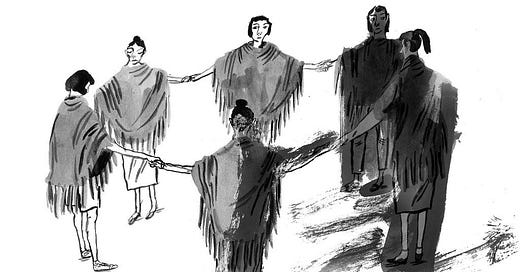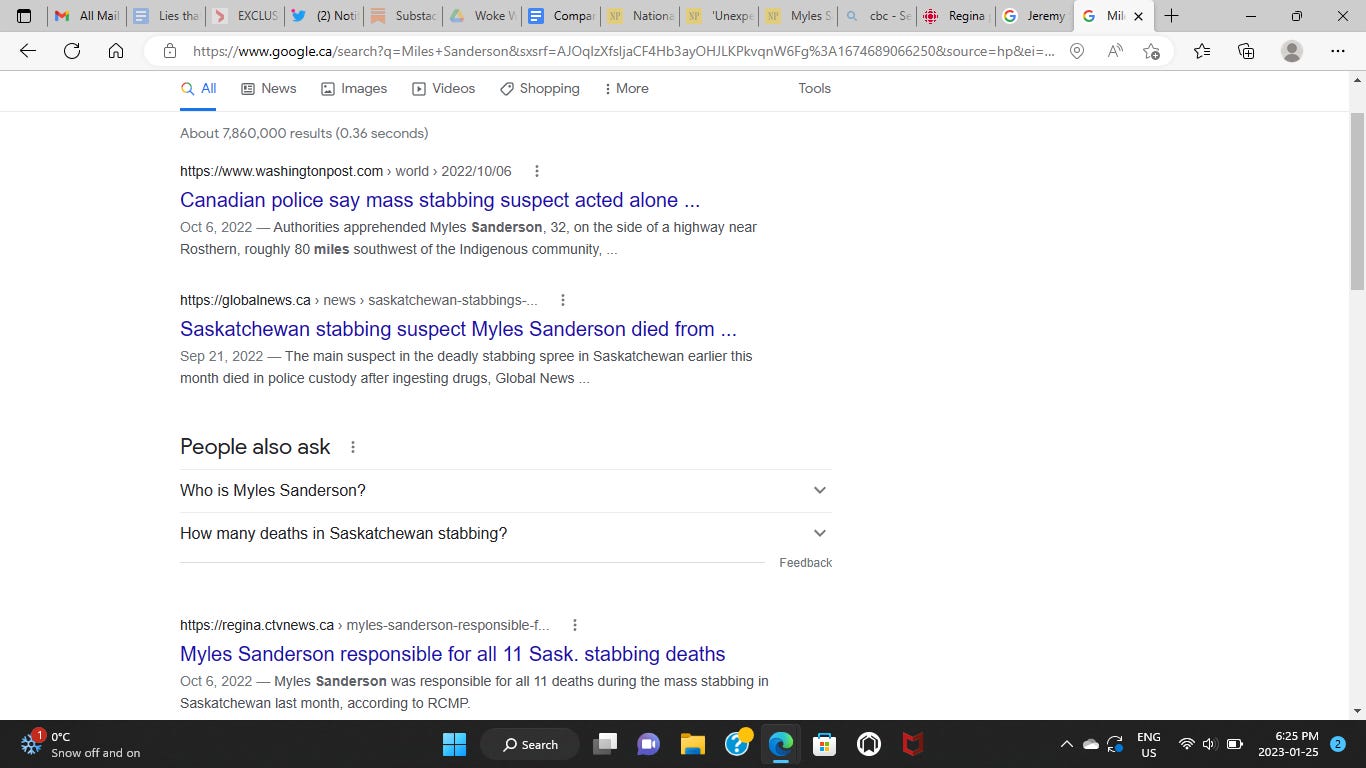By
& Brian GiesbrechtOn February 12th, a 29 year-old indigenous man accused of killing his wife and three children, and one other female relative, was charged for the massacre which occurred the previous day. Ryan Howard Manoakeesick had been in foster care since the age of 8, and had a history of mental illness. His previous criminal record included only one conviction in 2019 for mischief of property. However the circumstances around the matter illustrate Manoakeesick’s struggle with drug addiction and psychological distress.
He was “confused and delirious,” as he was under the influence of methamphetamine when he committed the crime. Taken to the hospital but released later that day, he then entered a Tim Hortons where staff were compelled to lock themselves in the backroom and call 911 after Manoakeesick shattered an electronic display by hurling a glass mug at it.
Further, in 2021, he was arrested and charged with two counts of impaired driving causing bodily harm, but released by police on a summons to appear in court. During the judicial process Manoakeesick went AWOL. His trial had been set for August of last year, but his lawyer lost touch with him. An arrest warrant was issued. On July 14th, Manoakeesick was arrested and held for four days. He was released on bail despite arguments from the Crown that detention was necessary to “ensure he attends future court dates.”
From a November 16th True North report filed by Hymie Rubenstein:
“Contrary to the prevailing activist narrative, why people impulsively commit murder is poorly understood by scientists, but it is likely related to a neurological inability to control feelings of anger as they interact with those around them, especially under the influence of alcohol or drugs. For mass murderers, the trigger sometimes arises from years of personal disappointment and failure that results in a combination of profound hopelessness and deep-seated resentment.”
At a news conference, Manitoba’s grand chief of the Assembly of Manitoba Chiefs, Cathy Merrick, said, “It’s not our way as a people, it’s not our way in our culture and our language… violence is something that we have learned as a people.”
Even before the blood spilled by Manoakeesick has dried, the stage is being set to rationalize his atrocity. The first to weigh in are indigenous leaders, then politicians and the media. The legal system also has a rationale for the violence perpetrated by indigenous men. It was the Gladue sentencing guidelines, which apply only to indigenous Canadians, that permitted Manoakeesick’s release, allowing him then to slaughter his family. If the judicial system was sensible, and not corrupted by identity politics, Manoakeesick would have been kept in custody until he was able to get the help he desperately needed.
The media’s complicity in the rationalizing, downplaying, deflecting, and excusing of indigenous perpetrated violence, especially when the victims are indigenous, which they are the majority of the time, is particularly disturbing. Indigenous-on-Indigenous violence does not fit the Social Justice narrative of an ongoing “settler colonial” genocide. However, white people are not harming indigenous people. Indigenous people are harming indigenous people, and pretending otherwise does nothing but perpetuate the awful “ongoing” tragedies occurring in indigenous communities.
The 2019 executive summary of the final report of the Missing and Murdered Indigenous Women and Girls Inquiry accuses Canada of past and present “acts of genocide of Indigenous peoples,” which it claims is caused by “settler colonialist structures.” Everywhere one turns, a blood libel narrative which places non-indigenous Canadians as genocidal settlers, is deployed in deliberate defiance of all the known facts. The violence, rape and murder experienced by indigenous women are overwhelmingly perpetrated by indigenous men, not non-indigenous “settlers.” The false narrative of genocide in Canada, ongoing or otherwise, is hardwired into the sense making organs of society. Even the Google algorithm is captured by these falsehoods.
In the following screenshot image of google search results for the Manoakeesick story, surprisingly, the only headline that refers to the “man charged with murder” as an “Ojibwe man,” is the indigenous media outlet APTN News. When did cover for, instead of coverage of, accused indigenous maniacs become the business of mainstream media? Are white journalists so afraid to correctly identify accused murderers as indigenous, that they have abdicated their responsibility to inform the public? The authors think at least this much is abundantly clear.
Turning to a pair of stories involving horrendous crimes committed in 2022. One involves a shocking and heartbreaking massacre of multiple indigenous people at the hands of a deranged indigenous man with a history of violent criminality and substance abuse. In this case, beyond the initial shock of the vicious nature of the crime, the media had very little attention span. The other story involves a cast of characters which garnered lasting attention. In this case, the accused perpetrator is a white man, and the victims are indigenous women.
Myles Sanderson vs. Jeremy Skibicki
In September of 2022, on the James Cree Smith Nation in Saskatchewan, eleven women and men were stabbed to death and another eighteen were injured in what was one of the grisliest mass murders in Canadian history.
At the time, a google search for the killer, an indigenous man named “Miles Sanderson” (note: “Miles” is the wrong spelling, however the redirected Google results are no different than when “Myles” is spelled correctly) returned a collection of articles with dates primarily ranging from September 7, 2022 to October 6, 2022. The same search on the National Post and Global News websites delivered similar results. For the most part, after October 6, 2022, not much was said about Saskatchewan’s largest mass slaughter.
Querying “Myles Sanderson,” on the CBC’s website, returned four articles, but only one had anything to do with the killer. Global News returned a full page of articles, but the vast majority were on or before Oct, 6th. One exception was a November 1st story where we learned that Sanderson, over a 15 year period, was terribly violent with Vanessa Burns (the mother of his five children). And earlier, on September 24th the day before the stabbing rampage, we learned that Sanderson’s sister-in-law called 911 to report Sanderson and his brother Damien:
“He (Damien) had taken her car and was high and drunk, driving around the tiny Saskatchewan community with his brother, Myles, lurking around her father’s house and trying to intimidate him.”
But it was during the four day manhunt (which ended on September 8) when Canadians first learned from media reports that Myles Sanderson had a long and violent criminal history, including 59 criminal convictions - the most recent being assault with a weapon and assaulting a peace officer - despite all that, he had been released on parole in February of 2022.
The way in which the media treated the James Cree Smith Nation killings is telling when compared to the coverage in Winnipeg of a non-indigenous accused killer, Jeremy Skibicki. With Sanderson, there appeared to be none of the white hot vitriol directed against Skibicki, or the police, justice system or other institutions that is still playing out in Winnipeg.
Skibicki was charged in December of 2022 with the murder of four indigenous women in Winnipeg, Manitoba. If proven, this is a truly horrible crime that deserves the full attention of the public, and a demand that justice be done. In this instance, there was an enormous level of outrage from all quarters, and an outcry for redress. An anger not seen in the wake of the mass killing perpetrated by Myles Sanderson.
There appears to be selective outrage and demand for change that only occurs when the alleged perpetrator is non-indigenous. Indigenous women are abused and murdered by indigenous men every day of the week. According to StatsCan, between the years 2000 and 2015, “homicides involving an Indigenous victim (were) six times higher than the rate of homicides involving non-Indigenous victims.” Also, the majority (91%) of homicides involving an indigenous victim are committed by someone known to the victim, and one in six murders are committed by an intimate partner. Shockingly, forty-two percent of all female indigenous murders are at the hand of an intimate partner.
But these facts don’t seem to matter. In mainstream reportage concerning indigenous violence, they are simply not mentioned. If both the victims and perpetrator are indigenous, interest in the facts is low. However, when victims are indigenous and the perpetrator is non-indigenous, every last detail about the perpetrator becomes a matter of immediate public concern.
Why is this so?
Section 35 of the Charter of Rights and Freedoms, the Gladue sentencing scheme, the unique Indian reserve system - everything in our Canada system promotes the idea that Indians are to be treated in a different way from other Canadians. It should not be surprising that many indigenous Canadians have decided that the ordinary rules don’t apply to them, and that the Social Justice media portrays them as victims.
The Sanderson mass murder took many more lives than did the Skibicki case, and was certainly every bit as gruesome. But although there was extensive media coverage while the police investigation was ongoing, once the facts were known, that was it. The case was over. Everyone went back to their daily lives. No sustained outrage.
Again, why does there appear to be completely different standards depending on whether the perpetrator is indigenous or non-indigenous?
The images below contrast the google search results of the names of the two killers. Notice the absence of any images of Myles Sanderson on the top portion of the first page of Google's results, as opposed to the abundance of images of Jeremy Skibicki at the top of his first page.
Google search results for Myles Sanderson:
Google search results for Jeremy Skibicki:
When “Jeremy Skibicki” was queried on the CBC website - the same website that returned only one article for “Myles Sanderson” - several dozen articles appear which go into great detail about Jeremy Skibicki, like this in-depth investigation - A timeline of what we know about 4 slain Winnipeg women and alleged serial killer Jeremy Skibicki.
No such in-depth investigation into the Sanderson mass killing could be found on CBC’s website. They were not alone in their bias. The majority of legacy media acted this way, so did big tech - as seen in the google search result images above.
But an in-depth investigation into Myles Sanderson is exactly what was needed. Eventually an inquiry took place that revealed among other things, that while incarcerated, he failed a test of psychopathy which indicated his likelihood of committing more violent offenses. When one adds this to the big picture: his criminal history, his soft treatment by the justice system, the years of violence he committed against his own family, his alcohol and drug abusing lifestyle, and other social dysfunctions endemic to far too many indigenous communities, it is absurd that a decision to unleash this monster onto his family and community was made.
Sanderson’s story needs to be explained to Canadians so they can better understand what both the reserve system and the Indian Act has wrought. But instead, in the face of such gratuitous brutality, the requirement of the status quo remains that the media must either report as little as possible or defer to a rationale which excuses indigenous perpetrated violence, like “intergenerational trauma” caused by residential schools and colonialism.
Imagine if Sanderson had been non-indigenous. His crime involved ten times as many people as the Skibicki murders. Can one assume that the outrage level would be ten times as high? Alternatively, what if it came to pass that the Winnipeg suspect was actually indigenous? Would the outrage level continue at the same white hot level?
History tells us that it would not. Because the Sanderson case is only a particularly sensational example of gruesome abuse and murder involving indigenous women and indigenous perpetrators that occur routinely. And are not noticed. The facts are clear. The great majority of indigenous women who are abused or murdered are victims of indigenous men.
That the abuse of indigenous women is only noticed if the perpetrator happens to be non-indigenous is a deeply troublesome sign for our society. That indigenous leaders and writers ignore this obvious fact is particularly troubling. And when those people give excuses to the indigenous abusers - such as the usual laundry list of “systemic racism, “trauma” arising from past efforts to assimilate (today deemed cultural genocide) - the abuse will continue.
Until violent crimes against indigenous women are recognized as being equally reprehensible regardless of the ethnicity of the perpetrator, until the indigenous community accepts ownership of their very real female abuse problem, nothing will change.
The Winnipeg case is truly horrific. In November of 2023 Skibicki pleaded not guilty to all four counts of first-degree murder. His trial is set for April. If proven he must be punished to the fullest extent of the law. Those who prey on indigenous women are among the lowest of humanity. But such cases must not be allowed to divert our attention from the very real problem that too many indigenous men abuse too many indigenous women, and far too often, the conditions in indigenous communities are incubators of this violent social dysfunction.
Until the media, and the big tech search algorithms, are honest about the dysfunction and dependency in indigenous communities, and indigenous men are held to the same standards as are everyone else, nothing will change.
___
Thanks for reading. For more from these authors, read The Derogatory Use of ‘Denialist’
BREAKING NEWS: James Pew has contributed a chapter to the new book Gave Error: How The Media Misled us (And the Truth about Residential Schools). You can read about it here - The Rise of Independent Canadian Researchers
Also, for more evidence of the ideological indoctrination in Canadian education, read Yes, schools are indoctrinating kids! And also, Yes, The University is an Indoctrination Camp!
There are now two ways to support Woke Watch Canada through donations:
1) By subscribing to the paid version of the Woke Watch Canada Newsletter for - $7 Cdn/month or $70 Cdn/year
2) By making a contribution to the Investigating Wokeism In Canada Initiative, which raises the funds necessary to maintain and expand Woke Watch Canada’s research and investigation into Dysfunctional Canadian School Boards, Education, Indigenous Issues, Free Speech, and other areas of Illiberal Subversion and the Canadian Culture Wars.










This is such a relevant and cogent article, summed up best for me by: “That the abuse of indigenous women is only noticed if the perpetrator happens to be non-indigenous is a deeply troublesome sign for our society.”
Cathy Merrick's comment that, "violence is something we have learned as a people" is not only laughable but indicative of the hypocrisy and duplicity of the double standard characterizing indigenous offenders in Canada's justice system. One can only wonder and speculate why she did not end her statement with the popular Blame Game cliche of, "from forced attendance at Residential School." The author's are absolutely correct that the media has been purposely restrained in releasing information on this offender's criminal history and indigenous background, an omission that they have thankfully corrected and one in which I express gratitude for. Perhaps in the toxic fog of political correctness we are obliged to follow the advice of Robert Jordan who said, "that which cannot be changed must be endured".
"Political correctness is just tyranny with manners. I wish for you the courage to be unpopular. Popularity is history's pocket change. Courage is history's true currency." ~ Charlton Heston